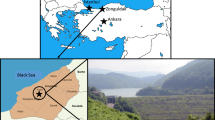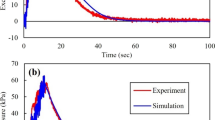Abstract
Offshore structures are generally vulnerable to strong seismic waves propagating through a loose seabed foundation. However, only limited attention has been paid to the seismic stability of composite breakwaters. In this study, a coupled numerical analysis is performed to study the seismic dynamics of a composite breakwater on a sloping loose seabed foundation under a seismic wave recorded during the 2011 Tohoku earthquake (M L = 9.0) in Japan. Computation results show that the developed numerical model is capable of capturing a variety of nonlinear phenomena in the interaction process between offshore structures and their loose seabed foundation. Under seismic loading, the loose seabed foundation away from the composite breakwater becomes completely liquefied. Because of the presence of the structure, the seabed foundation beneath the composite breakwater is partially liquefied. The composite breakwater undergoes significant subsidence, translation, and rotation; meanwhile, large lateral spreading occurs in the sloping seabed foundation. This investigation demonstrates that an advanced numerical method is promising in realistic evaluation of seismic performance of offshore structures.















Similar content being viewed by others
References
El Shamy U, Zeghal M, Dobry R, Thevanayagam S, Elgamal A, Abdoun T, Medina C, Bethapudi R, Bennett V (2010) Micromechanical aspects of liquefaction-induced lateral spreading. Int J Geomech 10(5):190–201
Elgamal A, Yang A, Lai T, Kutter BL, Wilson D (2005) Dynamic response of saturated dense sand in laminated centrifuge container. J Geotech Geoenviron Eng 131(5):598–609
Hsu TJ, Sakakiyama T, Liu PLF (2002) A numerical model for wave motions and turbulence flows in front of a composite breakwater. Coast Eng 46:25–50
Huang Y, Yashima A, Sawada K, Zhang F (2008) Numerical assessment of the seismic response of an earth embankment on liquefiable soils. Bull Eng Geol Environ 67(1):31–39
Lu J, Elgamal A, Yan L, Law K, Conte JP (2011) Large scale numerical modeling in geotechnical earthquake engineering. Int J Geomech 11(6):490–503
Manzanal D, Merodo JAF, Pastor M (2011) Generalized plasticity state parameter-based model for saturated and unsaturated soils. Part 1: saturated state. Int J Numer Anal Meth Geomech 35:1347–1362
Pastor M, Zienkiewicz OC, Chan AHC (1990) Generalized plasticity and the modelling of soil behaviour. Int J Numer Anal Meth Geomech 14:151–190
Pastor M, Chan AHC, Mira P, Manzanal D, Fernndez MJA, Blanc T (2011) Computational geomechanics: the heritage of olek zienkiewicz. Int J Numer Meth Eng 87(1–5):457–489
Sumer BM, Ansal A, Cetin KO, Damgaard J, Gunbak AR, Hansen NEO, Sawicki A, Synolakis CE, Yalciner AC, Yuksel Y, Zen K (2007) Earthquake-induced liquefaction around marine structures. J Waterway Port Coast Ocean Eng 133(1):55–82
Wang G, Sitar N (2011) Static and dynamic axial response of drilled piers II: numerical simulation. J Geotech Geoenviron Eng 137(12):1143–1153
Wang G, Xie Y (2014) Modified bounding surface hypoplasticity model for sands under cyclic loading. J Eng Mech 140(1):91–104
Xia ZF, Ye GL, HWang J, Ye B, Zhang F (2010) Fully coupled numerical analysis of repeated shake-consolidation process of earth embankment on liquefiable foundation. Soil Dyn Earthq Eng 30(11):1309–1318
Ye JH (2012a) Numerical analysis of wave-seabed-breakwater interactions. Ph.D thesis, Universtity of Dundee, Dundee, UK
Ye JH (2012b) Numerical modelling of consolidation of 2-D porous unsaturated seabed under a composite breakwater. Mechanika 18(4):373–379
Ye JH (2012c) Seismic response of poro-elastic seabed and compositebreakwater under strong earthquake loading. Bull Earthq Eng 10(4):1609–1633
Ye JH, Wang G (2015) Seismic dynamics of offshore breakwater on liquefiable seabed foundation. Soil Dyn Earthq Eng 76:86–99
Ye JH, Wang G (2016) Numerical simulation of the seismic liquefaction mechanism in an offshore loosely deposited seabed. Bull Eng Geol Environ (in press)
Ye B, Ye GL, Zhang F, Yashima A (2007) Experimental and numerical simulation of repeated liquefaction-consolidation of sand. Soils Found 3(47):547–558
Ye JH, Jeng D-S, Chan A (2012) Consolidation and dynamics of 3D unsaturated porous seabed under rigid caisson breakwater loaded by hydrostatic pressure and wave. Sci China Techn 55(8):2362–2376
Ye JH, Jeng D-S, Wang R, Zhu C (2013) Validation of a 2-d semi-coupled numerical model for fluid-structure-seabed interaction. J Fluid Struct 42:333–357
Zienkiewicz OC, Chang CT, Bettess P (1980) Drained, undrained, consolidating and dynamic behaviour assumptions in soils. Geotechnique 30(4):85–395
Zienkiewicz OC, Chan AHC, Pastor M, Schrefler BA, Shiomi T (1999) Computational geomechanics with special reference to earthquake engineering. Wiley, London
Acknowledgments
This study is supported by Hong Kong Research Grants Council (RGC) General Research Fund No. 16213615, RGC Collaborative Research Fund No. CityU8/CRF/13G, HKUST Post-Doctoral Fellowship Matching Fund, and National Natural Science Foundation of China under project No. 41472291. The authors also appreciate Professor Andrew Chan from Federation University Australia, who provided part of the computer code used in this study. Strong-motion data used in this study is obtained from KiK-net (http://www.kyoshin.bosai.go.jp/) operated by National Research Institute for Earth Science and Disaster Resilience (NIED) in Japan.
Author information
Authors and Affiliations
Corresponding author
Rights and permissions
About this article
Cite this article
Ye, J., Huang, D. & Wang, G. Nonlinear dynamic simulation of offshore breakwater on sloping liquefied seabed. Bull Eng Geol Environ 75, 1215–1225 (2016). https://doi.org/10.1007/s10064-016-0906-2
Received:
Accepted:
Published:
Issue Date:
DOI: https://doi.org/10.1007/s10064-016-0906-2




